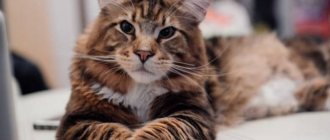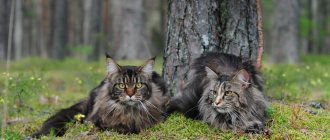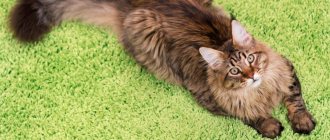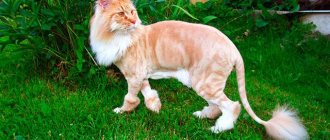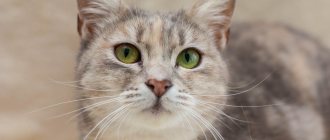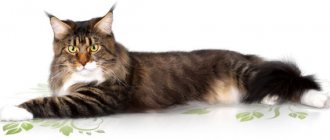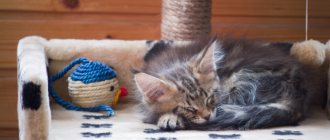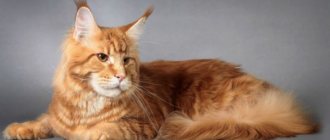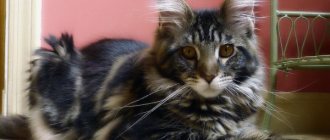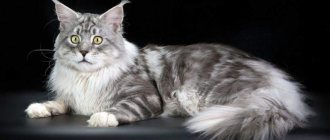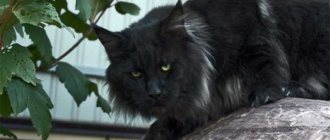The serious look of the Manx raccoon cat has always aroused a wary attitude among people. Even when the animal became a pet, and felinologists thoroughly studied its habits, many consider the character of the Maine Coon to be as harsh as its appearance.
The breed's phenotype is so strong that even a Maine Coon mestizo necessarily submits to its influence and carries the main breeding characteristics: large size, unusual coat and love of water.
Characteristic signs
Maine Coons have a rather specific appearance, with clear differences from the appearance of a natural mongrel cat.
Distinctive features of a Maine Coon pet:
- Large, triangular ears set almost at right angles, pointing upward rather than forward. The tip of the ear is decorated with a noticeable tassel - this is the main distinguishing feature of the appearance of a Maine Coon cat.
- The head is slightly elongated. The muzzle is large, with high cheekbones and, when viewed from the front, has a square shape.
- The eyes are more fox than cat-like: slanted, not round, but almond-shaped.
- The paws are large and heavy – this is another main distinguishing feature of the breed. There is fluff growing between the fingers.
- The tail is long, 2 times longer than that of ordinary cats.
- The coat is of medium length, but dense and voluminous.
- The body is large. Already at 5 weeks, a Maine Coon weighs the same as a 6-month-old regular pet. And a six-month-old pet looks almost no different from an adult ordinary cat.
- The physique is sinewy and strong. The skeleton is heavy. The chest is wide.
Health, diseases and vaccinations
They are in good health, but they often have a hereditary predisposition to hypertrophic cardiomyopathy, hip dysplasia and spinal muscular atrophy.
The cat may not be in the mood and may react to weather changes. But it should be shown to a doctor if:
Vaccination for Maine Coon cats is similar to the vaccination schedule for dogs. The first vaccination is given at 2 months, the second at 3 months, the third at 1 year, then annually. 10 days before vaccination, antihelminthic drugs are given. In some cases, you need to provide confirmation (a note about it is entered in a special column of the veterinary passport): transportation of the animal, mating, participation in an exhibition, placement in a hotel for pets.
How to distinguish a Maine Coon from a regular kitten
A newborn Maine Coon is almost no different from an ordinary kitten; the first noticeable signs of purebred individuals appear at 3 months of age. It is at this time that tufts grow on the ears, although sometimes kittens are born with tassels. If kittens over 3 months old do not have decorations on their ears, then they are not Maine Coons.
Also, from the age of 3 months, a purebred kitten’s skeleton begins to grow rapidly. The small pet becomes thin, awkward, and walks on long legs. There is no need to worry: the animal is not sick, and its body weight will soon increase.
A natural newborn kitten weighs 60–80 g, the weight of a purebred pet is twice as much – 150–180 g.
The small Maine Coon has an elongated head with high cheekbones, a long tail, dense coat, heavy paws covered with thick hair with fluff between the toes. An ordinary kitten has a neat, rounded head, a medium-length tail, and short, smooth fur.
Differences from mestizo
Crossing a Maine Coon with a regular cat is prohibited, but crossbreeds still exist, since they are more profitable to sell due to their low cost.
It is almost impossible for an inexperienced person to identify a mestizo cat, since its appearance contains features characteristic of an elite breed.
The only nuances by which you can distinguish a purebred Maine Coon from an ordinary kitten:
- price - mestizos are sold cheaper;
- size and body weight - a mixed-breed kitten is smaller than its purebred counterparts, and an adult Maine Coon cat should weigh at least 8 kg.
Differences from the Siberian kitten
The Maine Coon and the Siberian cat are native breeds adapted to survive in the wild, so there are many similarities in their appearance. But there are also differences:
- Maine Coon kittens have an elongated body and a noticeable neck, while Siberian “aboriginals” have a stocky, wide body and a short neck;
- Maine Coon cats have a large, heavy head, high cheekbones, angular, with a protruding chin, while “Siberians” have a neat muzzle, with smoothed cheekbones and chin;
- the former have large, vertically directed ears, decorated with tassels, the latter have ears that are tilted forward triangles with rounded sides;
- the physique of the “Americans” resembles a lynx, and the “Siberians” are more like Pallas’ cats.
Adult animal
It is not difficult to distinguish an adult Maine Coon cat from an outbred fake. The differences between animals are shown in the table.
| characteristics | ordinary cat | Maine Coon |
| muzzle | neat, small | hefty, high cheekbones, square (the so-called “box”) |
| paws | small | large, massive |
| lower jaw | smoothly rounded in profile | protrudes forward, giving the profile a square appearance |
| facial expression | typical for cats | always serious, stern |
| tail | about 25 cm | up to 55 cm |
| mustache | 6–7 cm | 16–18 cm |
| eyes | rounded | almond-shaped |
| ears | rounded-triangular, directed forward | triangular, pointed, directed upward, decorated with tassels |
| weight | 5–7 kg | 8–10 kg |
| wool | uniform length | dense and short on the head and paws, long on the back and sides, “pants” on the hips |
Varieties
Throughout the existence of Maine Coons, attempts were made from time to time to cross them with other cats in order to create a new breed. For example, in order for the Siamese color to appear in the breed, they tried to cross them with Siamese cats. But all the hybrid kittens and their descendants did not inherit the desired qualities and were not like their parents, and therefore there was no need to talk about breeding a new breed. What other Maine Coon crosses exist and how do they differ from purebred animals?
Crossed with a Siberian cat
The main advantage of a cross with a Siberian cat is the thick, long and fluffy fur that is common to representatives of both breeds, so such kittens will certainly be fluffy. They can also be larger in size than regular cats. A mixed breed with a Siberian cat will never reach the size of a Maine Coon and the characteristic tufts on his ears will also not appear. In addition, such cats will have a different head shape and a more massive build.
British mix
This British cross will have traits such as a calm disposition, quick wit, distrust of strangers and neatness. She will be smaller than the Maine Coon, she will have a fairly large and wider muzzle. If this is a kitten from a mating with a British Longhair, then it will grow up to be semi-longhaired. These mestizos are friendly and get along well with children, in addition, they are quite smart and quick-witted, although they are inferior in this regard to purebred cats.
Half-breed with a Norwegian cat
Such a mixed breed will probably be quite large and fluffy, with thick and dense water-repellent fur. He will probably even have small tufts on his ears, typical of Norwegians. The character of such a kitten is a little similar to the character of the Maine Coon: the mestizo will have a well-developed hunting instinct, and he will also be quite affectionate and affectionate towards people.
A cross between a normal cat
The most unpredictable combination, since an ordinary domestic cat can be the result of a mixture of many breeds. Here there is no need to talk about the similarity of mestizos with Maine Coons both in terms of appearance and character. With a high degree of probability, a mixture of genes from other breeds will turn out to be more dominant and will not allow even one or two of the characteristic breed characteristics of the original breed to appear. Perhaps such mestizos will grow a little larger than ordinary cats. They are also likely to have fairly thick, but somewhat short, fur.
Characteristic habits of Maine Coons
The Maine Coon even has a different character from an ordinary cat. Compared to a purebred pet, an “American” is more active, affectionate, friendly, and attached to its owner. He is flexible and understanding, and is not inclined to show aggression towards people.
Characteristics and habits of a purebred cat:
- the requirement to have your own corner in the house;
- recognition of only one person in the family as the owner;
- patient and friendly attitude towards children;
- love of water and water procedures;
- cleanliness;
- a tendency to indulge in self-indulgence, trickery, and active games;
- intellectual development, the ability to remember the owner's commands.
There are many cases of fraud when selling Maine Coons, so it is better to buy a kitten at an exhibition, or entrust the choice to a felinologist - a professional who knows the anatomical and physiological characteristics of cats of different breeds.
Also, when buying a pet, you need to ask the breeder for a document confirming the pedigree; it is issued only to purebred individuals. If she is not purebred, then she will only have a veterinary passport.
Source
Participation in exhibitions, documents
This American cat breed was formed many years ago. The task of breeders is to preserve and improve the gene pool. The participation of a simple cat in breeding negates their efforts.
Due to such factors, owners of hybrids cannot exhibit their pets in the breed ring. However, exhibitions where animals of unknown origin are judged are open to them. There they can show the pet and get a description if the cat is healthy, has a beautiful exterior, and an easy-going character. When the kittens grow up, it will become clear how large they will grow and what their show potential will be.
They are allowed into the ring upon reaching 10 months of age. The rules are the same as at regular exhibitions. Separate rings, strict judging. A mongrel pet is prepared with full responsibility: grooming, purchasing accessories. This is a great chance to show your favorite cats to specialists and get a lot of positive emotions from communicating with like-minded people.
Outbred cats are not registered anywhere. They cannot have a pedigree, only a veterinary passport with notes on vaccinations and treatment against worms, which the owner obtains at his own request. Subsequent mating with a coon will still result in his phenotype, and not a true Maine cat.
Why are they similar
As the name suggests, the Siberian breed originated in a harsh climate. Her ancestors were brought to Siberia from the European part of the continent. The conditions of the region caused a change in the genotype of cats. They became larger, more powerful, grew thick hair, and learned to survive in the cold.
The situation is similar with coons. Although it is not known for certain how they appeared in America, the climate and living conditions are very similar. The standard Maine Coon has the same length of hair, tufts on the ears, and is significantly larger in size than other domesticated relatives. The rich edge of the tail, its size, mane, decorating the hair on the paws are additional similarities.
If the Maine Coon is already a fully formed breed, then cats from Europe have been very diverse for a long time. This is explained by the fact that cat breeders for a long time could not come to a consensus on the characteristics of the livestock. Moreover, the breed is young.
Body structure with dimensions
The Maine Coon body standards describe the body as follows:
- rectangular format;
- elongated shape;
- high legs;
- wide chest;
- neck of medium length;
- muscular limbs;
- size from large to very large.
In the Siberian cat:
- legs of medium length;
- medium to large size;
- the neck is short;
- the chest is deep;
- the format is triangular, but the body is shorter;
- wide croup, back.
In addition, among them there are often massive individuals, especially males.
The main difference is in size, but Siberians have shorter legs and a deeper and slightly wider chest. This will make an adult Maine Coon appear much taller. Their tail tapers towards the end, but in other breeds it is rounded. For Coons it should reach the shoulder blades, and for Siberians it should reach the shoulder. Many experts talk about the slightly convex back of Siberians, although this is not visible under the fur and in movement. The overall impression is different. A one-year-old Maine Coon of a stretched size, with high and strong legs. Cats look more graceful than cats. Siberians are dense, muscular with a wide body. The average weight of coons is 9-11 kg, and their opponents in comparison rarely exceed 8 kg. Cats weigh even less; there are specimens up to 4 kg that fit the standard.
How much does an adult cat weigh?
By 15 months, the growth of the Maine Coon ends; until the age of three, domestic cats gain muscle mass. The weight of an adult male Maine Coon is 9-10 kg, a female Maine Coon weighs 7-8 kg. This is the average weight of the Mei Coon.
Males are often larger than females, but some females can weigh more than yearling males. The weight of a Maine Coon can change after castration, since they do not have hormonal fluctuations. Neutered dogs may be overweight, so it is important to provide pets with maximum physical activity and choose the right diet.
This is interesting!
There is often information that the height and weight of Maine Coons can reach 20-25 kg. This myth is very persistent, but it is not true. If someone claims that their cat weighs more than 12 kg, then the animal has problems with excess weight, and therefore health.
Head and muzzle
These body parts deserve special attention. The look and the shape of the eyes are the calling cards of the breeds. Every Maine Coon has a friendly and sometimes predatory look.
Other characteristics of Americans:
- long muzzle;
- pointed wedge shape;
- slightly convex forehead;
- prominent cheekbones with a high waist;
- prominent pads with vibrissae;
- there is a transition;
- strong chin.
If you outline the profile of a Coon with conditional lines, you can see the angles where the nose meets the forehead, near the chin and mouth. Siberians have smooth, rounded outlines.
The eyes in the Maine Coon breed are oval, slightly slanted, the degree of expression depends on the intrabreed type and breeding lines. The look is usually friendly, but sometimes the animal looks proud. The eyes of the Siberian cat are round, set wide at a barely noticeable angle.
The ears of Maine cats are large and almost vertical. In the second case, the shape is round, the dimensions are smaller, and the shells are tilted forward. Both breeds prefer tassels on the tips. The distance between the ears of Siberians is greater than that of Maine Coon Cats.
Coat and color
American cats have a rather thick undercoat, medium-long coat with a silky structure. There is no covering hair resembling a cloak on the lower part of the body. The Siberian breed has wool that feels elastic to the touch, the fluff is denser, and the coat is thick and long. Otherwise the parameters are the same.
Acceptable colors are the same, with the exception of color-point Neva Masquerade cats, which are essentially Siberian cats. This coincidence in standards is natural. The preferred colors for these cats include the tabby pattern common in the wild. After all, coons and Siberians developed independently, learned to hunt in forests, snow-covered fields and remain unnoticed by prey, large predators.
Prohibited colors:
- chocolate;
- lilac;
- faun;
- cinnamon;
- acromelanic (changing due to ambient temperature).
The latter includes color point. This color is accompanied by blue eyes and characteristic darkening on the face and other parts of the body in cats.
Both types of coat are easy to care for, but the Maine Coon needs regular brushing. The shedding of Siberians is pronounced; during this period the animal sheds most of its fur, which is noticeable by the sparse undercoat. Before the cold weather they grow again.
Problems and breeding
A decent breeder will never approve of the meaningful mating of a coon and an outbred female. This often leads to the following consequences:
- A cat may die in childbirth if the kittens are very large;
- The purity of the breed is lost;
- You cannot conduct breeding activities with a half-breed;
- Unpredictable animals in terms of mental health and health.
As a rule, mestizos are sold at low prices. They are of no interest and lose value for breeding. The work of the breeder is highly appreciated. The price for a purebred kitten cannot be below a certain level.
Differences between a coon and a purebred kitten:
- Large sizes;
- Recognizable muzzle profile;
- Large ears, possibly with a tassel;
- Semi-long topcoat;
- A long tail;
- Strong bones;
- Wide chest.
Usually a cross between Coons and nobles looks simpler. Even purebred animals with minor defects or weak types are sterilized to prevent them from producing offspring. Sometimes even experienced people have unforeseen circumstances when a Maine Coon mates with a noblewoman. Even in this situation, animals are given away free of charge or for a symbolic amount, with the condition of mandatory sterilization in the future. Before buying a coon, you should look at his parents, find out their origins and study pedigrees. The breeder always hands over the documents (metrics) of his graduates. Otherwise, there is a risk of acquiring an outbred animal. Kittens move to a new home no earlier than 3 months, after vaccinations and other necessary procedures. Mestizos are usually given away earlier due to the high costs of raising them.
In the recent past, there have already been attempts to register non-purebred coons. Several breeds were used to breed them:
- Siamese;
- Bengal.
A similar situation is observed in the dog world, but there designer breeds have become successful due to their cute appearance and clever advertising. Both types of kuna hybrids have remained unrecognized by the felinological community. The work did not live up to the hopes of the breeders. The resulting kittens turned out to be of different types, without the desired characteristics.
Problems also arise when cat owners realize they don't have a coon. Many raised animals end up in shelters or worse, on the street. Growing up at home, they cannot withstand the difficulties they encounter on their own. In addition, uncontrolled reproduction begins, and the number of street children is rapidly increasing. They are susceptible to infections, their immunity is weakened, and the infection spreads further.
Character, temperament and content features
Both giant and medium cats are friendly. Many note similarities in character and temperament. Cats from overseas have innate devotion to their owner, just like their distant relatives from the forest group. General characteristics include balance, playfulness and developed intelligence.
Siberian breeders claim that their pets may be suitable for people suffering from animal allergies. In this case, the modern Maine Coon is equal to other brothers from the cat family. By the way, mature cats are more likely to cause allergic reactions than females. Cats from Siberia and American forests mature slowly, and they receive approval late due to their large size. But the first ones reach the age of puberty earlier and are able to bear offspring as early as six months.
Source
The biggest size
Several of the largest coons in the world have been recorded. The largest Maine Coon seen at shows weighed 15 kg. But the exhibition organizers canceled the “fattest cat” nomination. Sometimes owners overfed their pets, which led to a shortened life of the cats.
This is interesting!
The largest cat in length was included in the Guinness Book. The size of the Maine Coon from Nevada was 132.2 cm in length. Today this record has not yet been broken, so for now it is the largest cat in the world. The length was also recorded at 122 cm.
How to distinguish a Maine Coon by external data
Without practical experience, it is difficult to distinguish a purebred cat from a Maine Coon mestizo, so it is better to seek help from a specialist who knows the little-known nuances of the breed. But there are a number of obvious signs for comparing kittens with and without pedigree.
These include the length and color of the coat, eye color, size, weight of the baby and other developmental features of the animal.
Important! The best time to visit the nursery and choose a Maine Coon is 2 to 3 months after birth. At this age, the distinctive characteristics of the breed are already obvious.
By length, quality and color of coat
A Maine Coon kitten's fur is soft and pleasant to the touch. There are no adult attributes in the form of a fluffy mane and panties on the hind legs yet, but even in childhood, the cover on these parts of the body is more pronounced than in ordinary cats.
It is also possible to determine whether a Maine Coon is a real Maine Coon or not by the color of a kitten’s fur at a young age. Colors unacceptable for these animals: chocolate and cinnamon (cinnamon), rich lilac colors and lightened shade of coastal sea sand (fawn).
This breed does not have color-point or acromelanic colors.
By weight and size
The next distinguishing feature is the difference in weight and size of an ordinary cat and a purebred Maine Coon.
| Boys (kg) | Girls (kg) | |
| Birth | 0,12-0,16 | 0,1-0,14 |
| 1 month | 0,65-0,75 | 0,55-0,7 |
| 2 months | 1,2-1,5 | 1-1,4 |
| 3 months | 2,8-3,7 | 1,6-2,4 |
| 4 months | 3,1-3,9 | 2,5-3,6 |
| 5 months | 3,3-4,2 | 2,8-4 |
* Information about weight depends on the breeding qualities of the parents and the number of kittens in the litter.
By the age of three months, the body weight of an ordinary cat, in comparison with a Maine Coon, is approximately 2 times less.
Important! There is a universal formula for determining the weight of a Maine Coon - its age in months, multiplied by a factor of 0.5. Under any conditions, the kitten cannot be lighter than the resulting number (kg).
By physique
The following characteristics will help determine the characteristics of the breed characteristics of Maine Coon kittens by constitution (structure):
- The body is long, elongated, rectangular in shape, the front and hind limbs are of the same height.
- The paws (especially the front ones) are powerful and straight.
- The long, even tail reaches the shoulder blades.
According to general indicators, a Maine Coon next to an ordinary cat of the same age looks like Gulliver in the land of Lilliput.
If you have doubts about the purebred kitten, you need to pay attention to the animal’s head - a real Maine Coon has the following external signs:
- The ears are large, located almost vertically, with a slight tilt forward.
- Box-shaped muzzle with high cheekbones.
- In profile, a “hall” is clearly visible between the bridge of the nose and the forehead, which can be formed with varying degrees of bending.
By the eyes
The Maine Coon's eyes are large and slanted. There are no specific requirements for the color of the iris - it can be green, amber, golden, blue, even heterochromia (eyes of different colors) is allowed.
By growth and development rate
At three months of age, you can easily distinguish a Maine Coon by its size - it will be 2 times larger than a regular cat. By 6 months, the cat will be the same size and weight as a normal adult cat.
If we are talking about mestizos, then the problem becomes more complicated. Depending on the parental qualities inherited, such cats sometimes grow as actively as their purebred relatives.
Important! It is almost impossible to distinguish a Maine Coon kitten from a mestizo (mix of breeds) at one month of age.
Possible offspring
No significant changes are expected in terms of coat color. Most domestic cats without admixture from other breeds have the colors acceptable in Maine Coon Cats. But genetics suggests unexpected results. Mutations, such as polydactyly, which is common in coons, are likely to affect part of the litter. Coat color and pattern are inherited according to established laws.
Useful to read: Recommendations for choosing a Maine Coon
Science knows interesting facts about eye color. Usually it does not depend on the color of the coat, but blue pigment accompanies color-point colors (Siamese cats), and less often white. In practice, if you cross a green-eyed coon with a blue-eyed female, the offspring will most likely take after the father for this trait. This happens because green is dominant to blue. When white kittens are born, the situation may change.
All Maine Coon cats have medium-length fur. If you cross a representative with a smooth cat, the litter will be short-haired. The birth of kittens with long hair is possible if there are two long-haired parents.
Character and behavior are unpredictable in this combination. Street cats are more aggressive by nature, this is dictated by the laws of survival in difficult conditions. Pedigree cats are softer, because purposeful work has been carried out for decades to consolidate behavior that is comfortable for humans.
Weight and body structure are also difficult to calculate, but most half-breeds are distinguished by their impressive dimensions, although they are inferior to their purebred parents. Kittens are born with different characteristics, some are smaller, some are larger.
Metis requires the same careful attention as a purebred animal. A balanced diet, walks, and the love of the owner are mandatory criteria for the happiness of any pet.
Head and muzzle
These body parts deserve special attention. The look and the shape of the eyes are the calling cards of the breeds. Every Maine Coon has a friendly and sometimes predatory look.
Other characteristics of Americans:
- long muzzle;
- pointed wedge shape;
- slightly convex forehead;
- prominent cheekbones with a high waist;
- prominent pads with vibrissae;
- there is a transition;
- strong chin.
If you outline the profile of a Coon with conditional lines, you can see the angles where the nose meets the forehead, near the chin and mouth. Siberians have smooth, rounded outlines.
The eyes in the Maine Coon breed are oval, slightly slanted, the degree of expression depends on the intrabreed type and breeding lines. The look is usually friendly, but sometimes the animal looks proud. The eyes of the Siberian cat are round, set wide at a barely noticeable angle.
The ears of Maine cats are large and almost vertical. In the second case, the shape is round, the dimensions are smaller, and the shells are tilted forward. Both breeds prefer tassels on the tips. The distance between the ears of Siberians is greater than that of Maine Coon Cats.
Useful to read: How to distinguish a Maine Coon from an ordinary cat
Features and differences in the appearance of the Maine Coon
Speaking about the features and differences from other cat breeds, the first thing you need to notice is the size of the Maine Coon. As you know, coons are the largest recognized cat breed. We are, of course, not talking about several tens of kilograms, but you must agree that an eight to nine kilogram cat with a long body, a large bushy tail and luxurious fur looks impressive.
The coat of this breed is not evenly distributed over the body, it becomes longer from the shoulders and back to the bottom, but the variety of colors is a topic for a separate article - “ Maine Coon color”
A powerful neck, large head, square muzzle, high cheekbones are another, but not the last, distinctive features of the Maine Coon.
The look of these giants is also special, it is also called the “signature look of the Maine Coon”, full of confidence and calm, a little arrogant, it is not like the look of any other cat breed.
Maine Coon tassels yet , but let's start with the ears themselves. The ears are large and wide at the base, taper towards the tip and end with another distinctive feature - ear bones, which gives the coon a kind of forest lynx appearance. Note that brushes can be seen not only on the ears of these wonderful cats, but also on their paws! Yes, the fur between the toes is so long that it forms rather cute tassels.
How are these not different? They are even very different! This can be seen even in photos or pictures, but personally, the images were not enough for me to get acquainted with Maine Coons, so I went to the exhibition. And as a result: cunomania captured me.
How are these not different? Even very different! This can be seen even in photos or pictures, but is it
Source
Maine Coon: features of the breed
Today, Maine Coon cats are in high demand among animal lovers. However, the popularity and fairly high cost of kittens of this breed often lead to the fact that half-breeds and even kittens that only vaguely resemble them in appearance (for example, Norwegian Forest or Siberian) appear on the market under the guise of Maine Coons. How to avoid becoming a victim of scammers?
To know how a Maine Coon and an ordinary cat differ from each other, you need to know the characteristics of the Maine Coon breed. The impressive size of Maine Coon cats is one of the main and obvious signs of this breed. However, to gain confidence that it is he in front of you, it is not enough.
The Maine Coon should have a large and muscular, but at the same time, very long body. The tail and paws of the Maine Coon are also very long and at first glance, they may even seem disproportionate to it. The Maine Coon's head lines are sharp, rather than smooth and rounded like most other cats. The Maine Coon's tall ears stand high and have an angular shape that is uncharacteristic of most cats. Maine Coon eyes are typically large, round and slightly slanted; The most common colors include gold, amber and green. There must be tassels at the tips of the ears. The Maine Coon's coat is dense and long, but not smooth. The Maine Coon's color should not be lilac or chocolate.
By nature, Maine Coons are extremely calm, affectionate cats. Manifestations of aggression on their part are extremely rare. High intelligence allows them to easily learn all kinds of commands and get used to many necessary procedures.
Knowing Maine Coon
characteristics of the breed, it will be easier for you to buy a purebred kitten. In order to gain greater confidence, before purchasing a Maine Coon, be sure to visit several exhibitions with the participation of interesting
Source
I decided to get a cat. Exactly KOTA! It’s just that I’m powerlessly rushing between the Siberian and the Maine Coon. Both are good, but there are no acquaintances with cat fakes, and the pictures and blogs are only praises.
In addition to the large size, I want the cat to meow a little and not be cloyingly intrusive. Cat lovers, please respond and tell us about the pros and cons of the breeds.
half of the respondents have no idea about coons. Mikhail Sharafutdinov, if you suddenly bother to read my answer, you should know that the Maine Coon breed is over 150 years old. Tch, he also spits bullshit. If any cat decides to do something, it will do it regardless of the breed.
Both Coons and Siberians are aborigines - very smart and very self-sufficient animals. I don’t know many Siberians, I have very close contact with coons (I have two coons and kittens) and there are absolutely no problems with them. and the familiar coon breeders too))) despite the menacing look, the cats are very kind, no matter what they do to them, even bathe them, even give injections. claws never come out. Siberians are cats from Russian folk tales. smart and decent))) so choose with your heart and wallet, funds allow - take a coon (almost half the price for castration) there is some tension in money - take a Siberian.
the Maine Coon is quite spontaneous, if he wanted to pee in the corner, then they will do it, playfully cheerful, we have a regular gray one with long ears, he screams a little only when he asks for food, flexible, my friend has a Siberian, he is quite disgusting and angry, a Maine Coon
Of course kun! They are much larger, more sociable, more obedient and playful than Siberians. The largest coons are the old-type ones. Cats have wide muzzles and large heads. Extreme sportsmen have a narrower muzzle, high ears, and smaller sizes. But they also cost a lot of money.
Siberian cats. Medium to large in size, with excellent physical ability, their strength and power is softened by the sweet expression of their muzzle. The body leaves a rounded overall impression
Friendly cat forum
Super-Knowledgeable
“There is nothing more difficult than distinguishing between a “bad” Maine Coon, a “bad” Norwegian and a “bad” Siberian” - this is a saying that has developed in the felinological world. “Bad” - in the sense of the severity of breed characteristics. It is quite easy for an expert to distinguish good representatives of these breeds, which cannot be said about a person “from the street”, whose sphere of interests does not include cats.
The fact is that the appearance of each of these three breeds is based on the same image of a certain “wild forest cat”. It’s not that their breeders were trying to exactly copy representatives of this biological species (the forest cat Felis silvestris). In the appearance of a Maine Coon, a trained eye can detect features more characteristic of a lynx (high-set ears with tufts, emphasized cheekbones and muzzle, high legs), and in the appearance of a Siberian - a distant hint of a Pallas's cat (small ears, a massive head with smooth outlines) . Nevertheless, each breed is designed to create the impression of an aboriginal cat from the harsh forests - large and powerful, with very thick, elongated hair.
About twenty years ago, it was much more difficult to distinguish a representative of the Norwegian Forest from the Maine Coon than it is today - neither one nor the other breed had any particular specificity of traits. Despite the fact that the origin of these animals is well known: they were bred not just from isolated populations, but also on different continents, there were almost more similarities between them than differences. This situation is explained simply: the initial “material” for creating the breeds was outbred domestic animals. cats formed in similar conditions: on farms in Maine or in the villages of Norway. And the climate of these regions is not so strikingly different from each other (when compared, for example, with Brazil or Japan). With this way of life, cats of medium and large size, with strong bones, developed muscles, and “dressed” in dense fur received an advantage. Any other specific breed characteristics were not fixed in these populations, since the owners of farms and farms, if they selected the best among their animals, it was only by “mouse catching”, it is clear that areas with a similar climate - and with similar keeping of cats - are not limited to Norway and Maine, but occupy large areas in Eurasia and North America. Accordingly, cats of this “primitive” type are common among them. It is impossible to find a modern exhibition specimen of a Norwegian or Maine Coon in a village near Moscow, but it is quite possible to find cats that have a number of characteristics typical of these breeds. Today, both the Norwegian Forest and the Maine Coon have the status of national breeds, and the beginner class for them is closed in most organizations. In other words, animals without a pedigree going back to American or, respectively, Norwegian ancestors cannot be recognized as representatives of these breeds and allowed for breeding. This is done in order to protect the gene pool of the breed and give it greater genetic stability.
However, in the early stages of the formation of these breeds, the question inevitably arose: whether to preserve the most common type of animal in the aboriginal population or to give the emerging breed some unique, characteristic features that do not contradict the notorious image of the “wild forest cat.” The conflict between the desire to preserve the gene pool of the aboriginal population and the creative development of breed characteristics is one of the most difficult for breeders at the stage of breed domestication. Of course, I would like to achieve some kind of reasonable balance between these trends. If we limit ourselves to only preserving the most common characteristics in the aboriginal population, the risk increases that the breed will turn out to be inexpressive, uninteresting to potential owners (in other words, to buyers), which will not add to its popularity and may threaten its very existence. If you go to the other extreme - exaggerate some of the existing characteristics or introduce new ones, and even resorting to introductory crossings for this, then you can lose all the biological foundations of “aboriginality”, getting simply another cultural breed of cats, connected with their ancestors only title.
American breeders nevertheless preferred to emphasize a number of characteristics of the breed, giving it a catchy and recognizable appearance (even if some of these characteristics contradicted the image of a wild cat from cold forests - for example, the large ears of a Maine Coon in a harsh climate would be at obvious risk of frostbite). More conservative Scandinavians followed the path of preserving traditional characteristics, trying to achieve overall harmony in the appearance of animals without highlighting individual extreme features. By the way, with such development, the breed often turns out to be subject to fashion trends, as if breeders, not being able to invest their energy in the development of “permitted to extreme” characteristics, are trying to direct it to one or another “average” characteristic - to the limits allowed by the standard (and sometimes going beyond these limits). Norwegian forest dogs were no exception - at some stage of their development (approximately in the late 80s and early 90s of the last century), extremely long heads were in fashion. A few years later, fashion returned to the classic equilateral triangle, and the efforts of breeders focused on the formation of a high line of eyebrows - the so-called helmet of Norwegian cats. The “third side of the triangle”—the Siberian—began to emerge as a cultural breed later than the other two, and its representatives at that time were extremely heterogeneous. There were several reasons for this phenomenon: firstly, animals in the primary breeding groups were recruited “from all over Great Rus',” and this is a territory much larger than Norway and the state of Maine, and its climatic conditions are very diverse.
Super-Knowledgeable
Secondly, cats from large cities predominated in these groups: Moscow, Leningrad (St. Petersburg), Krasnoyarsk, etc., and the gene pool of the urban cat population is subject to constant “mixing”. Therefore, when the question arose about writing a standard (more precisely, standards drawn up by different organizations), the originators of the breed relied not so much on the prevalence of certain traits in cat populations in Siberia itself, but rather. on the historically established idea of the Siberian cat as an aborigine of the settlements of the taiga zone. An important role in drawing up the standard was played by the desire to give the breed a specific appearance that distinguishes it from the Maine Coon and Norwegian Forest. In this, the actions of the originators were subject to the general felinological rule: the new breed should not resemble existing ones. So how do representatives of the “aboriginal triangle” differ from each other today? The Maine Coon is perhaps the largest or, more precisely, tall breed: with a powerful bone structure and a wide chest, it is distinguished by a long body. The strong, muscular legs of these cats are prescribed by the standard as “average length in proportion to the body,” but since the body is quite long, we can say that the Maine Coon’s legs are also long. The Siberian usually impresses not so much with its size (although large sizes are preferred for this breed), but with its power, which in seasoned cats turns into some massiveness. The body, like the powerful limbs, is of medium length. However, since the back and croup, as well as the chest of Siberians, should be wide (and the chest is also quite deep), these cats seem to be somewhat squat. The appearance of the Norwegian successfully combines strength and grace. The Norwegian Forest breed is distinguished by its strong rather than massive build; the body of these animals can be of medium or even greater length” (cats are usually longer than males). The legs are quite tall, but thanks to their strong bones and dense muscles they do not look thin at all. The breed is dominated by medium-sized animals (although the standard stipulates both medium and large), but the “rich” coat visually increases the size of these cats. The most striking differences are demonstrated by the heads of the “triangle” breeds. The Maine Coon's head is shaped like a wide, modified wedge, with high, prominent cheekbones. The impression of angularity is complemented by a square muzzle with emphasized whisker pads. The head of the Norwegian Forest Cat is shaped like an equilateral triangle, or, in the terminology of other organizations, a “moderate wedge”. Its outlines are soft, rounded, the cheekbones do not stand out, and the smooth line of contours at the transition to the muzzle does not change its direction. The Siberian's head has the shape of a wide and short trapezoid (an inverted trapezoid, to be more precise). The cheekbones are quite low, and from them to the whisker pads there is a smooth, rounded contour line. Small differences between the three breeds can be seen in the organization of the profile, in the area of the transition from the forehead to the nose. In the Maine Coon, a soft but clearly defined bend in this area is expected, without an accentuated stop or sharp break. Approximately the same option of transition from the forehead to the nose is also welcomed in the Siberian, only the length of this section is shorter (due to the shorter head). The line of transition from the forehead to the nose of the Norwegian is often described as “straight” or “flat”, but one should not attribute a truly straight “oriental” profile to this breed. The Norwegian Forest has high, smoothly contoured eyebrows, due to which a slight “false” bend of the line is formed at the transition from the forehead to the base of the nose, a sort of delicate change in its direction. A pronounced break or stop is categorically unacceptable!
Large, high and straight set, and even decorated with tassels, Maine Coon ears can serve as one of the calling cards of this breed. The not so expressive, but harmonious ears of the Norwegian forest cat are set relatively high, and in such a way that the lower part of the outer line of the ear seems to continue the line of the triangular head. The distance between the Siberian's small, wide ears at the base is quite large, with the outer line of the ear almost vertical, and the ears themselves noticeably tilted forward. Ear furry - tufted and densely brushed - is desirable in all three breeds.
The Maine Coon's eyes are described by the standard as oval, widely spaced. The compilers of the Norwegian Forest breed standard focus on the large size and “openness” of the eyes, defining their shape as broad oval. But in the Siberian breed standard, the eye shape is usually written as round, with a wide set. Here I would like to make one digression. Standards for recognition of the Siberian breed were submitted to international felinological organizations at different times and, which is very sad, by different Russian clubs, whose actions were not coordinated with each other. Their “Siberian” standards were somewhat different from each other, and apparently also underwent some changes when translated into another language. As a result, noticeable discrepancies arose between the standards of different international organizations, sometimes leading to complete absurdity. Thus, the term “round eyes”, which is quite widely interpreted by Russians, began to look like “almost round” in TICA standards, and as “round” in CFA standards. Round eyes, naturally, must be accompanied by an open expression, and now American breeders, looking at photographs of our Siberians, are surprised at their “not round enough eyes” and reproach (!) for the lack of an “open facial expression.” Perhaps Russian standards (at least Russian!) should be more clearly defined on this point - after all, the Siberian breed should evoke associations with a strong, natural animal, and not with a soft toy.
Maine Coon and an ordinary cat have many differences, however, the market is filled with a huge number of kittens that are passed off as real purebreds. In fact, at best it will turn out to be a mestizo - a cross between a Maine Coon and an ordinary cat, or it will even turn out that the Maine Coon was not even close to that.
In order not to make a mistake in choosing, you need to clearly know the characteristics characteristic of this breed. Before you go for the long-awaited kitten, it is worth studying in advance how the Maine Coon and an ordinary cat differ.
The handsome Maine Coons, with their appearance and large size, are more reminiscent of a real wild animal than a pet, due to which the demand for representatives of the breed has been steadily growing in the last decade.
Additional characteristics of the Maine Coon breed
Additional external signs of a true Maine Coon include tufts on the ears, the presence of hair between the toes and a luxurious tail. If a kitten's tassels have not grown at 2-3 months of age, they will no longer exist. But this does not discard him from breeding and does not close the way to diplomas at exhibitions.
Friendliness and sociability
An adult Maine Coon is truly responsive, friendly and attached to its owner. But this is not a unique sign that indicates the “purity” of the breed.
Love for water
Unlike ordinary cats, Maine Coons love water. They swim without being forced and at the same time snort contentedly, which shows their owner their pleasure. If a pet is afraid of water, it probably has a mixture of other breeds in its genes.
Advantages and disadvantages of the breed
Metis have their pros and cons. Interbreeding carries the risk of genetic abnormalities. They do not always appear in the first generation. In addition, an adult animal may have an aggressive character and an unbalanced psyche. These defects are not noticeable in kittens, but may appear after puberty.
In addition, mestizos do not always inherit even part of the characteristics of their purebred parent. In this case, there is a possibility that the animals will not find owners and will end up on the street.
The advantages of mestizos include their good health. Even if such a pet does not look like its purebred parent, it can become a member of the family. Low price is also an advantage.
What is the weight of an adult cat and Maine Coon cat?
The size and weight of a kun depends on many factors. The state of an adult cat is established at birth. The size of the animal is affected by:
- Genetics. If the kitten's parents were large and in good health, there is a high probability that the kittens will also be of impressive size.
- Floor. Males are larger and taller than females. Males also grow faster than their female counterparts.
- The use of hormonal drugs in a cat during certain periods.
- Conditions in which kittens grow up.
- Stress factor. If an animal is constantly exposed to stress, the endocrine system of the animal suffers first, which negatively affects further growth.
- Proper nutrition. It must be balanced. By following proper nutrition, healthy and strong coons will grow up with the correct size and weight.
Typically, a cat stops growing and gaining weight at the age of three. During this period it should reach its maximum size. For a male, the weight can range from 9-12 kg, castrated individuals can weigh 13-16 kg. All cats should be between 7-10 kg. The height at the withers can reach 25-40 cm. The length of the body from the nose to the tip of the tail can reach 100 cm, that is, 1 m. The maximum length established by the kunas is 1.23 m.
Thoroughbred animals with a good pedigree will look larger and more massive than their counterparts. This is dictated by a special genetic exterior.
Comparison of Maine Coon and regular cat
If the kitten is not met in a nursery, and there is no opportunity to see its parents, you need to pay attention to the following signs:
- The muzzle - in an ordinary cat it is pointed, but in a Maine Coon the lower jaw and chin meet at an angle of 90°. The front part has the same geometry – from the nose to the chin.
- Mustache. Everything is simple here - the long and hard whiskers of a Maine Coon cannot be confused with the thin whiskers of an ordinary cat.
- The luxurious tail extends approximately ¾ of the length of his body and will be 2 times longer than that of a purebred cat.
Height and weight by month
Newborn kittens weigh up to 120 grams; by the end of the first month of life, kittens weigh up to 600 grams, males - up to 800.
By the end of the second month, females weigh about 1.3 kg, males - up to 1.5 kg.
At 3 months, kittens usually double their size: females - up to 2.4 kg, males - up to 3.6 kg.
At 4 months, girls weigh up to 3.6 kg, boys - up to 3.9 kg. By six months, the kitten’s growth slows down, females reach from 2.8 to 4 kg, males from 3 to 4.5 kg. By 8 months, the Maine Coon adds about 1.5 kg to its weight. At 9 months, cats weigh up to 6 kg, males - up to 7 kg. At 10-11 months, the weight of girls is up to 7 kg, boys - up to 7.5 kg. By the age of one year, kittens can reach 8 - 9 kg.
How to distinguish a Maine Coon kitten from a regular one
It is not difficult to see the differences between an older Maine Coon and an ordinary cat of the same age, even if the latter had purebred ancestors and is similar in appearance to them.
- The Maine Coon can and loves to stand on its hind legs. In this position, he freezes for a long time in front of the TV or at the windowsill.
- You can’t force an ordinary cat to carry something in its teeth on command, but a Maine Coon will bring you slippers and run for a stick.
- Communication skills. Loneliness is more likely the lot of ordinary cats, but not the Maine Coon.
One of the described qualities can manifest itself in all cats, regardless of breed. But in combination they are characteristic only of the Maine Coon.
Differences between adults and ordinary people
Among other representatives of the cat family, the Maine Coon stands out, first of all, for its size. These are large cats, they have powerful paws, a strong musculoskeletal system, and even a larger muzzle than other members of the cat family. Secondly, his habits give him away - self-esteem, pride. Taken together, these features resemble wild royalty. What to pay attention to when in doubt:
- The purebred pet has a “box” muzzle and slanted eyes. Simple cats have round eyes, their muzzle is either triangular or round, and there is no characteristic shape.
- Another feature is that the ears are pointed and topped with original tassels. Domestic cats cannot boast of such an appearance.
- Maine Coons reach a weight of 8 to 10 kilograms. An ordinary adult cat will weigh no more than 5 - 6 kilograms. An adult cat of noble blood, even at first glance, will seem large, heavy, and impressive.
- You can distinguish a domestic cat by the degree of vegetation. The fur on the face and paws of pedigree cats will be thick and short, becoming longer towards the back and sides, forming a fluffy collar and a kind of mane, and there are pronounced “pants” on the hind legs. In simple cats, the hair is usually uniform - either short or elongated - with undercoat.
- Another sign of pride for feline aristocrats is a luxurious tail. It is unusually (unlike all other breeds) fluffy, spreading, reaching a length of 45 to 60 cm. In simple animals, tails usually do not grow longer than thirty centimeters.
To be sure to understand where an adult Maine Coon is and where an ordinary cat is, you must study the breed from photographs. When the eye is “observed”, the differences will immediately catch the eye.
Maine Coons are distinguished by their character and habits. These are independent, humane animals. They resemble dogs in character. They love to play with water, splashing it out of a bowl or with a stream from the tap, and bathe with pleasure. They have a high level of intelligence and are easy to train. The owners of these cats constantly hear their voice - they purr, meow, purr, rumble, and accompany their actions with sounds. Moreover, their high tone does not at all correspond to their respectable appearance. Maine Coons have a melodic and even squeaky voice.
Maine - Coon cats will be larger than cats as adults.
What else to pay attention to
There are additional ways to protect yourself from purchasing an ordinary cat disguised as a purebred Maine Coon. They relate not to the appearance and characteristics of the kitten itself, but to the conditions of its sale and execution of the transaction.
An experienced breeder will not place a kitten under 3 months of age into the wrong hands. By this period, all vaccinations and treatment against parasites must be completed. At this age, the pet is already completely ready for socialization.
A purebred Maine Coon, unlike an ordinary cat or mixed breed, must have documents confirming the breed.
In them, experts describe the advantages of a cat and place it in one of three groups:
- The highest level is the Show class, which implies exhibition qualities and value for breeding.
- Breed group with good genetic characteristics and prospects for breeding work.
- Pet cats. Maine Coons fall into this category, the owners of which do not intend to go to exhibitions and raise kittens.
The Maine Coon is a huge fluffy cat with tufted ears, a long fluffy tail and powerful paws. It is impossible to confuse it during adulthood with another breed. But in childhood, all kittens seem the same, and their spontaneous purchase often turns into a regular lottery. Therefore, the main guarantee that your pet belongs to a certain breed will be the presence of a pedigree.
Participation in exhibitions, documents
This American cat breed was formed many years ago. The task of breeders is to preserve and improve the gene pool. The participation of a simple cat in breeding negates their efforts.
Due to such factors, owners of hybrids cannot exhibit their pets in the breed ring. However, exhibitions where animals of unknown origin are judged are open to them. There they can show the pet and get a description if the cat is healthy, has a beautiful exterior, and an easy-going character. When the kittens grow up, it will become clear how large they will grow and what their show potential will be.
Useful to read: Features of carriers for Maine Coons
They are allowed into the ring upon reaching 10 months of age. The rules are the same as at regular exhibitions. Separate rings, strict judging. A mongrel pet is prepared with full responsibility: grooming, purchasing accessories. This is a great chance to show your favorite cats to specialists and get a lot of positive emotions from communicating with like-minded people.
Outbred cats are not registered anywhere. They cannot have a pedigree, only a veterinary passport with notes on vaccinations and treatment against worms, which the owner obtains at his own request. Subsequent mating with a coon will still result in his phenotype, and not a true Maine cat.
Tips for choosing
Meikoons are especially loved for their impressive size: cats reach up to 8 and even 10 kilograms. Cats are smaller. Like any other animals, Maine Coon kittens differ from each other in character, breed quality, and color. The most important thing is to choose an honest breeder and correctly identify the breed, without accidentally buying a mixed breed. Maine Coon is a native breed; they are not crossed with other species, which means that purebred kittens are expensive and are of interest to scammers.
If an animal is purchased for exhibitions, then purebredness is one of the most important qualities; a cat will simply be disqualified for being a crossbreed.
Source
